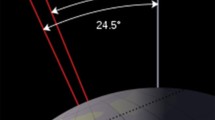Abstract
The climate is a notion of average time for a region and for a longer period. While short-term weather describes the state of the atmosphere, the climate is a long-term pattern of weather in one area (Ahrens and Henson 2016). The climate has many more items from the average condition of the atmosphere, because the full description of the environment should also include changes and extremes in the atmosphere to accurately describe the overall character of the area. The important elements in the descriptions of the climate are the regime of temperature and the precipitation regime, because they have the greatest impact on people and their activities have effects on the distribution of vegetation and soil development. There are various factors that affect climate worldwide, among which the most important are:
Access this chapter
Tax calculation will be finalised at checkout
Purchases are for personal use only
Similar content being viewed by others
References
Ahrens, C. D., & Henson, R. (2016). Meteorology today, an introduction to weather, climate and the environment (11th ed., 662 pp). Boston: Cengage Learning.
Allaby, M. (2007) Encyclopedia of weather and climate (Rev. ed., Vols. 1 and 2, 756 pp). New York: Facts of File Science Library.
Barry, R. G., & Hall-McKim, E. A. (2014). Essential of the earth’s climate system (Vol. 24, p. 259). Cambridge: Cambridge University Press.
Bretherton, F. P., Bryan, K., & Woodes, J. D. (1990). Time-dependent greenhouse-gasinduced climate change. In: Climate change: The IPCC scientific assessment, pp. 177–193 [J. T. Houghton, G. J. Jenkins and J. J. Ephraums (eds.)]. Cambridge, United Kingdom and New York, NY, USA: Cambridge University Press.
Burroughs, W. J. (2007). Climate change. A multidisciplinary approach (Vol. 378, p. 24). Cambridge: Cambridge University Press.
Gates, W. L. (1992). AMIP : The atmospheric model intercomparison project. Bull. Amer. Meteor. Soc, 73, 1962–1970.
IPCC. (2014) Climate change 2014: Synthesis report. Contribution of working groups I, II and III to the fifth assessment report of the intergovernmental panel on climate change [Core Writing Team, R.K. Pachauri and L.A. Meyer (eds.)]. IPCC, Geneva, Switzerland, 151 pp.
Lau, W. K. M., & Waliser, D. E. (2012). Intraseasonal variability in the atmosphere–ocean climate system (2nd ed., p. 613s). Chichester: Springer Praxis Publishing.
Mathez, E. A., & Smerdon, J. E. (2018). Climate change, The science of global warming and our energy future (2nd ed., p. 520). New York: Columbia University Press.
National Research Council. (2002). Abrupt climate change: Inevitable surprises. Washington, DC: The National Academies Press. https://doi.org/10.17226/10136.
Oliver, J. E. (Ed.) (2005). Encyclopedia of world climatology (854 pp). Dordrecht: Springer.
Philander, S. G. (Ed.) (2008). Encyclopaedia of global warming and climate change (Vols. 1–3, 1283 pp). Thousand Oaks: SAGE.
Roy, I. (2018). Climate variability and sunspot activity: Analysis of the solar influence on climate (Springer atmospheric sciences) (p. 218). Cham: Springer.
Trenberth, K. (2010). Climate system modelling (820 p). Cambridge: Cambridge University Press.
Warner, T. T. (2011). Numerical weather and climate prediction (Vol. 23, p. 526). Cambridge: Cambridge University Press.
Author information
Authors and Affiliations
Rights and permissions
Copyright information
© 2021 Springer Nature Switzerland AG
About this chapter
Cite this chapter
Spiridonov, V., Ćurić, M. (2021). Climate and Climate Change. In: Fundamentals of Meteorology. Springer, Cham. https://doi.org/10.1007/978-3-030-52655-9_24
Download citation
DOI: https://doi.org/10.1007/978-3-030-52655-9_24
Published:
Publisher Name: Springer, Cham
Print ISBN: 978-3-030-52654-2
Online ISBN: 978-3-030-52655-9
eBook Packages: Earth and Environmental ScienceEarth and Environmental Science (R0)




